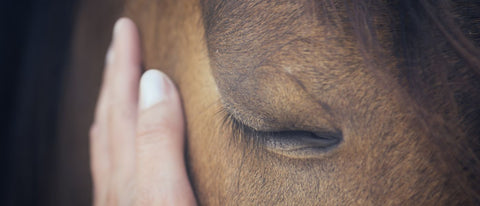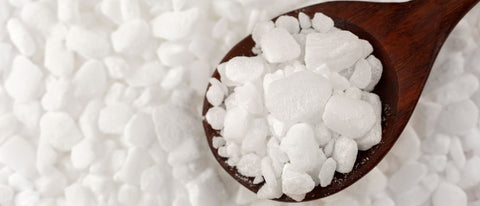
Florian ist aufgewachsen auf einem Bauernhof. Umgeben von Pferden, entdeckte er früh seine Faszination für diese majestätischen Tiere. Inspiriert von seiner reitbegeisterten Mutter, entwickelte er das Nahrungsergänzungmittel - Pferdegold. Seine tiefe Verbundenheit zur Natur und die leidenschaftliche Hingabe zu Pferden trieben ihn an, sein Unternehmen zu gründen.
Equine metabolic syndrome (EMS) is a significant health challenge in the horse world.
It is a complex metabolic disorder that often occurs in overweight horses and is closely linked to insulin resistance.
This disease can have far-reaching consequences for the health and well-being of your horse.
In this article, you will learn everything you need to know about EMS in horses: from the basic symptoms to effective diagnostic and treatment methods.
The goal of this article is to give you a solid understanding of EMS so that you, as a horse owner or caregiver, can recognize the signs of this condition early and respond appropriately.

What is EMS in horses? Definition and main causes
If you enter the world of horses, sooner or later you will certainly ask yourself the question: “What is EMS in horses?” The EMS abbreviation stands for Equine Metabolic Syndrome (EMS) .
It is an increasingly common metabolic disease in horses, characterized primarily by obesity and insulin resistance .
This disease develops gradually and can lead to serious health consequences, including laminitis.
EMS is known as a "disease of affluence" because the main causes are an overabundance of food and a lack of exercise.
EMS is a metabolic disease in horses that consists of various symptoms.
Typical signs are fat deposits on the mane crest, above the eyes, on the chest and on the neck, which are noticeable in EMS.
Loss of performance, lethargy, muscle weakness and other symptoms such as dull coat, rapid sweating and increased fluid requirements can also indicate this disease.
Important to note: Not every overweight horse has EMS, and conversely, lean horses can also be affected.
Owners often report reduced performance and poorer muscle development in their horse, which can often be an early sign of EMS.
In mares, EMS can also cause fertility problems.
Risk factors for EMS include obesity, genetic predisposition, and a diet that is too rich in calories and carbohydrates .
Light-feeding horses such as ponies and certain breeds such as Arabians and Fjord horses are particularly susceptible to EMS.
EMS disease doesn't develop overnight, but gradually. If EMS is suspected, a thorough diagnosis by a veterinarian is essential.
Typical diagnostic methods include blood tests to check insulin and glucose levels. Elevated insulin levels in the blood are a clear sign of EMS.
It is recommended that the test be repeated at least once within three weeks if EMS is suspected to ensure accuracy.

Perfect for your horse: Pferdegold® supplementary feed!
These specially developed supplements support your horse's diet and provide it with natural nutrients. Made in Germany, grain-free and drug-free, they come with a 30-day money-back guarantee.
Try it now!How environmental toxins can affect equine metabolic syndrome
Environmental toxins, especially poisonous plants, can pose a serious threat to the health of horses.
Not only can they cause acute poisoning, but they can also have long-term effects on the metabolism and immune system of horses, which can indirectly increase the risk of equine metabolic syndrome (EMS).
Plant toxins, such as the alkaloids, glycosides, and saponins found in poisonous plants, can cause a variety of symptoms, including cardiac arrhythmias, respiratory paralysis, diarrhea, and cramps.
These toxins can affect the liver and other important organs, resulting in increased metabolic stress.
In addition, environmental toxins ingested by horses can impair the functioning of important organs such as the liver and kidneys.
However, these organs in particular are crucial for detoxifying the body and maintaining a healthy metabolism.
Impairment of their function can lead to a buildup of toxins, which in turn can disrupt metabolism and contribute to metabolic problems such as EMS.
Some detoxification methods, such as the use of volcanic minerals (bentonite or zeolite), are said to help minimize the effects of environmental toxins and
- mold toxins (mycotoxins),
- Heavy metals and
- other pollutants
bind in the digestive tract and remove from the body.
To protect horses from environmental toxins in general, it is important to keep them away from poisonous plants and to ensure safe and controlled feeding.
The classic symptoms & first signs of EMS
Equine Metabolic Syndrome (EMS) is a subtle and insidious disease in horses. The first symptoms of EMS in horses can easily be overlooked because they are often not immediately apparent.
EMS is characterized by fat deposits in certain areas of the body, particularly on the mane, above the eyes, on the chest, and on the neck . These visible signs should alert horse owners.
In addition to the symptoms that may indicate Equine Metabolic Syndrome (EMS), there are a number of other signs that are important for horse owners and caregivers to recognize:
-
Loss of performance and general lethargy: Even with minor exertion, the horse shows a noticeable reduction in performance and a general listlessness, which may indicate impaired metabolic function.
-
Muscle weakness and wasting: Despite apparently good feeding condition, affected horses often suffer from muscle wasting.
This contrasts with the fat accumulation typical of EMS and indicates an imbalance in energy metabolism.
-
Stiff movements, similar to colic: This results in painful hardening of the muscles, the horse's movements become stiff and uncoordinated, which indicates metabolic disorders in the muscle tissue.
-
A dull coat and hair: This symptom reflects the generally poor health and impaired nutrient absorption in EMS.
-
Increased fluid requirements and more frequent urination: This sign indicates impaired kidney function and possibly the onset of insulin resistance.
-
An increased risk of infections: The increased glucose level in the blood can weaken the immune system, making the horse more susceptible to infections.
-
Signs of laminitis: This is a common and serious complication of EMS, caused by impaired glucose metabolism, which can lead to inflammation in the hoof.
-
Insulin resistance: EMS horses often suffer from insulin resistance, which can lead to circulatory disorders, which usually first manifest in the hooves as laminitis.
-
Fertility disorders in mares: EMS can affect hormonal balance, leading to reproductive problems.
These symptoms may occur individually or in combination and are a clear indication that a thorough veterinary examination is necessary to diagnose and appropriately treat EMS.

How is EMS diagnosed in horses?
The diagnosis of EMS in horses is usually made through a combination of clinical examination and laboratory tests .
First, external signs such as fat deposits in characteristic places such as
- mane crest,
- over the eyes,
- on the chest and
- Neck respected.
Other symptoms such as the loss of performance mentioned above, muscle weakness, dull coat and rapid sweating can also indicate EMS.
One of the most important tests is the determination of fasting levels of insulin and glucose in the horse's blood .
These values can provide clues to insulin resistance, a key feature of EMS.
However, measuring fasting insulin and glucose levels alone is not always sufficient, especially in the early stages of the disease. Therefore, dynamic tests such as the oral glucose tolerance test (OGT) are often used.
During the OGT, the horses are kept fasting for at least six hours before they are given sugar water and blood samples are taken.
The results of this test provide information about the body's response to glucose and the effectiveness of insulin.
Since EMS often occurs in overweight horses, the Body Condition Score (BCS) can also be used for diagnosis. The BCS allows for an objective assessment of a horse's nutritional status.
In addition, further tests such as determining blood lipid levels can be carried out to obtain a comprehensive picture of the horse's health.
What impact does the disease have on the health of horses?
Equine metabolic syndrome (EMS ) and the associated insulin resistance can have serious effects on the health of horses.
Insulin resistance is characterized by a reduced metabolic response to insulin, the hormone that normally lowers blood sugar levels by transporting glucose (sugar) from the blood into the body's cells.
In insulin-resistant horses, this mechanism functions only to a limited extent, which leads to a permanently elevated blood sugar level.
One of the main problems with EMS is that the horse's body no longer responds properly to insulin, a hormone important for regulating blood sugar levels.
This can happen in two ways: Either the horse produces too much insulin when it ingests sugar, leading to abnormally high insulin levels in the blood (known as insulin dysregulation, or ID ), or the body's cells no longer respond properly to insulin, hindering the absorption of sugar from the blood into the cells (known as insulin resistance, or IR ). Both conditions impair the horse's ability to properly regulate its blood sugar levels.
Insulin resistance can have various causes, including genetic factors, lack of exercise, and overfeeding. Horses suffering from EMS often tend to be overweight, which further exacerbates the problem. Overweight horses produce more adipose tissue hormones, which can increase insulin resistance and disrupt normal metabolic regulation.
One of the most serious consequences of insulin resistance in EMS is the development of laminitis . Laminitis is a painful inflammation of the hoof capsule that is often associated with EMS. High blood insulin concentrations are an important trigger factor for laminitis, and horses with EMS are at particularly high risk of suffering from this disease.
Would you like to learn more about how to treat laminitis or, ideally, prevent it? Then take a look at our comprehensive guide "Laminitis in Horses: Tips for Prevention & Treatment."

Pferdegold® supplementary feed!
Pferdegold is a small family business from Bavaria with a big dream: to produce the best horse feed. We see ourselves as a family of equestrians who want to provide your horse with the ideal nutrition. 100% natural and perfectly tailored to your horse's needs.
Try it now!EMS treatment: What really helps?
The treatment of equine metabolic syndrome (EMS) in horses focuses on two main areas: weight reduction and dietary adjustment.
Weight loss and exercise
The aim of treatment is to encourage the horse to lose weight and thereby improve insulin sensitivity.
Regular and sustained exercise is a crucial component of treatment. It is recommended that horses be ridden regularly unless acute laminitis is present.
Keeping horses in an open stable, which allows for more exercise, is also preferable to keeping them in a box.
Feed change
A horse with EMS should be fed a low-carbohydrate diet. An EMS horse must be fed a low-energy diet, with an emphasis on low-carbohydrate hay. Conventional concentrates, fruits and vegetables, and treats should be avoided .
Grazing should be allowed only to a limited extent, if at all. Additionally, the use of oil as an energy source can be considered if the horse becomes too thin due to the diet.
Life expectancy
With timely diagnosis and appropriate treatment, horses with EMS can lead a normal and healthy life.
However, continuous monitoring and adjustment of feeding and exercise are crucial for the success of treatment and the prevention of long-term complications such as laminitis.

How to prevent equine metabolic syndrome in horses: 6 expert tips
Effective prevention of EMS requires careful management in the areas of feeding, exercise and health monitoring.
Here you will find six valuable tips from experts on how to protect your horse from EMS.
1. Mineral feed: Support for a balanced nutrient supply
Mineral feeds can be a key component in the diet of horses , especially those prone to EMS. These supplements provide a balanced mix of essential nutrients important for maintaining a healthy metabolism.
They contain important vitamins and minerals that can have a positive effect on the horse's overall health. When choosing a mineral feed, you should make sure it is tailored to your horse's specific needs.
2. Why the real energy requirement is crucial in horse feeding
Your horse's actual energy needs are a crucial factor in preventing EMS. It's important that energy intake—whether through hay, concentrate, or other feed—is precisely tailored to the horse's activity level, weight, and health status .
Excessive energy intake , especially from starchy and sugary foods, can quickly lead to obesity and thus an increased risk of EMS . By closely monitoring your horse's energy needs and adjusting them accordingly, you will contribute significantly to its well-being.
Individually tailored feeding helps maintain the ideal weight and supports a healthy metabolism.
3. The importance of roughage as a basis for feeding
Roughage, such as hay and grass, should form the foundation of a horse's diet, especially those prone to EMS. This type of feed is rich in fiber and supports a slow and steady energy supply. This is especially important because horses with EMS are prone to fluctuations in blood sugar levels.
Roughage also promotes healthy digestion and intestinal flora, which is essential for maintaining the horse's overall well-being. By properly balancing roughage in the diet, you can reduce the risk of developing EMS while ensuring your horse receives all the nutrients it needs.
4. The advantages of open stable keeping
Open-stall housing offers many benefits for the health and well-being of horses. It allows the animals to move freely , thus promoting natural movement and muscle development.
This is especially important for horses prone to EMS, as regular exercise helps prevent obesity and boosts metabolism. The social interactions in the open stable also promote the horses' psychological well-being and help reduce stress-related behavioral problems .
5. The key to EMS horses: Regular exercise
Regular exercise is crucial for the prevention and treatment of EMS in horses. It helps control excess weight and improves insulin sensitivity, which is important for regulating blood sugar levels.
Horses with EMS benefit from a tailor-made exercise program that promotes both their physical and mental health.
It's important that exercise be regular and varied to maintain the horse's interest and motivation. This can be achieved through varied activities such as trail rides, groundwork, or free running in a safe environment .

6. Feeding strategies: How an expert can help
A nutritionist can make an important contribution to your horse's health, especially when it comes to the prevention or management of EMS .
These professionals can develop individual feeding plans that are tailored to your horse's exact needs, taking into account factors such as
- Race,
- Weight,
- Activity level and
- existing health conditions.
With their expertise, they can help you find the right balance between roughage, concentrates, and any supplements to prevent obesity and promote a healthy metabolism.
Professional advice is particularly important for horses that already show signs of EMS or are at increased risk of developing this metabolic disease.
Cushing's or Equine Metabolic Syndrome: How do I tell the difference in my horse?
Recognizing the difference between Cushing's disease and equine metabolic syndrome (EMS) in horses can be challenging because both conditions can present with similar symptoms .
While Cushing's disease, also known as equine Cushing's syndrome (ECS), mostly affects older horses and is characterized by an overactive adrenal cortex , EMS targets impaired insulin regulation and often occurs in younger horses .
A prominent symptom of Cushing's disease is a long, curly coat that persists even in warm weather. EMS, on the other hand, is often characterized by obesity, especially of the neck and shoulders, and an increased susceptibility to laminitis .
It is crucial to consult a veterinarian if you suspect any of these conditions, as early diagnosis and treatment can be essential to the further course of the disease.

Hereditary factors in EMS
Heredity plays an important role in equine metabolic syndrome (EMS). Studies show that certain horse breeds, such as ponies, Morgan horses, and Arabian horses, may have a stronger predisposition to EMS. This suggests that genetic factors may play a significant role in the development of this condition.
If one parent suffers from EMS, the risk that the foal will also develop EMS during its lifetime increases. However, this does not mean that every foal born to an affected parent will automatically develop EMS.
Environmental factors such as diet and exercise also play an important role in the prevention and management of EMS. Therefore, it's crucial to keep both factors in mind and consider your horse's genetic history and lifestyle.
Why are diseases of affluence increasing in horses?
The increase in diseases of affluence in horses is a growing problem, primarily due to modern husbandry and feeding practices . With changes in our horses' lifestyles, which often include less exercise and higher calorie intake from concentrated feeds, the risk of diseases such as equine metabolic syndrome (EMS) and Cushing's disease increases.
Many horses today spend more time in stables than on pasture, leading to reduced physical activity . Furthermore , overfeeding with high-energy foods and a lack of adequate feed management contribute to unhealthy weight gain and potential insulin resistance.
This lifestyle contradicts the natural way of life and the needs of horses, which were originally designed for a life on the steppe with plenty of exercise and a high-fiber diet . Therefore, it is important to raise awareness of species-appropriate husbandry and nutrition in order to minimize the risk of diseases of affluence in horses.
Conclusion
As a horse owner, you have probably long been aware that your horse's health is influenced by a variety of factors, be it genetic predisposition or daily care and nutrition.
At Pferdegold, we are committed to ensuring that you are as well informed and equipped as possible to ensure your four-legged companion lives a long and healthy life.
The prevention of diseases such as EMS or Cushing's disease can often be positively influenced by conscious feeding and sufficient exercise.
At Pferdegold, we believe in a holistic approach that always encompasses both nutrition and lifestyle. Remember that, as a horse owner, you can play a crucial role in your horse's health. A balanced diet, sufficient exercise, and attention to detail can make all the difference.
Which horse breeds are particularly susceptible to EMS?
Certain horse breeds show an increased susceptibility to equine metabolic syndrome (EMS).
These primarily include ponies, including Shetland, Welsh, and Dartmoor ponies, as well as certain horse breeds such as Morgans and Arabian horses. These breeds are more prone to obesity and insulin resistance, both of which can be key factors in the development of EMS.
As a horse owner of these breeds, it is therefore particularly important to ensure an appropriate diet and sufficient exercise.
Is EMS curable in horses?
EMS in horses is not completely curable, but it can be effectively managed to improve the horse's quality of life and minimize the risk of complications. Treatment focuses on a strict diet, weight management, and regular exercise.
These measures can help alleviate the symptoms of EMS and reduce the risk of laminitis, a common complication of EMS. Close collaboration with a veterinarian is essential to develop the best management program for the affected horse.
What shouldn’t EMS horses eat?
For horses with EMS, it is important to minimize the intake of rapidly digestible carbohydrates. High-sugar feeds such as molasses, sweet feeds, or certain grains should be avoided.
Even fresh grass can be problematic under certain circumstances, especially during the growing seasons of spring and fall, as it can contain high sugar levels. It is recommended to focus on a high-fiber, low-glycemic diet and always consult with a veterinarian or experienced equine nutritionist.
IMPORTANT:
Pferdegold is not a substitute for veterinary diagnosis or treatment . The information contained in this article is for general informational purposes only and is intended to help improve your horse's well-being.
Pferdegold products do not treat or cure diseases , but rather support your horse in correcting nutritional deficiencies through targeted nutrient intake. However, they are not a substitute for professional advice from a veterinarian or specialist.
If your horse has any health problems , we strongly recommend consulting a veterinarian . Pferdegold assumes no liability for decisions made based on the information provided here.
Discover the world of horses and read our next guides!
- Metabolic diseases in horses: causes and tips
- Icelandic horses » All information about their appearance, character & more!
- Laminitis in horses: Tips for prevention and treatment
- Feeding horses optimally and naturally » That's what matters!
- Muscle building in horses: nutrition, exercises & tips
-
Cushing's syndrome in horses: tips on nutrition and care

















